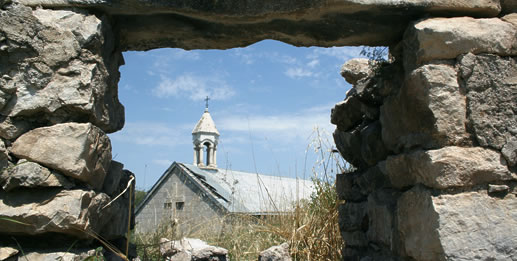Pilgrimage and Tourism
The Amaras Monastery is a popular destination for anyone visiting the Nagorno Karabakh Republic (NKR). The monastery attracts a growing number of pilgrims and tourists from all over the world. While a big portion of international visitors to Amaras are ethnic Armenians from diasporan communities in the United States, Russia, France, Iran, Lebanon, Syria, Greece, Australia and Argentina, non-Armenians have been flocking to Nagorno Karabakh in ever increasing numbers.
All international visitors see in Nagorno Karabakh a unique Christian civilization and an ancient land of stunning natural beauty that has overcome incredible odds to preserve its identity, spiritual values and independence.
Religious pilgrims are a special and new category of visitors to Nagorno Karabakh. They arrive both from Armenia and abroad, attracted primarily to Nagorno Karabakh’s key religious sites. In addition to Amaras, they customarily include but are not limited to the Gandzasar and Dadivank monasteries, which possess important relics or are associated with lives and deeds of Christian saints and martyrs, such as: St. John the Baptist, St. Joseph of Arimathea, St. Pantaleon (St. Panteleimon), St. Dadi, St. Khad, St. Elisha (St. Yeghishe), St. Gregory the Enlightener, St. Grigoris, St. Mesrob Mashtots, and St. Vardan Mamikonian.
Nagorno Karabakh’s list of Christian martyrs prominently includes St. Grigoris, bishop of the Eastern Lands of Armenia and St. Gregory the Enlightener’s grandson who, in the 4th century, preached the Holy Gospel in the Northern Caucasus. St. Grigoris martyred for his Christian faith and was interned in the mausoleum located underneath Amaras’ Church of St. Grigoris.
Some pilgrims add to their itineraries the city of Shushi, the old capital of Nagorno Karabakh, which was in the hands of Azerbaijani forces during the war. The fact that Armenians regained control over the city in 1992 is considered by these pilgrims as a manifestation of divine care and direction.
Despite the difficulties, Nagorno Karabakh’s nascent tourism industry has made great strides towards achieving its critical objective: putting the ancient land of Artsakh on the world’s map of tourist attractions. To implement the ambitious program to attract visitors to the republic, the Nagorno Karabakh authorities have encouraged local and foreign businessmen to invest in developing the tourism industry and related infrastructure, including new roads, hotels, restaurants and travel agencies. By bringing together private and public sectors to promote and market Artsakh as an international tourism destination, the government also aims at increasing jobs and generating income for small and medium-sized enterprises, not only in the capital—Stepanakert—but also in less developed, and sometimes forgotten, rural areas on the periphery.
OTHER ATTRACTIONS OF THE NAGORNO KARABAKH REPUBLIC
The Amaras Monastery is by far not the only religious and historical landmark of note in the country. There are many other spectacular destinations in Nagorno Karabakh. Below is an incomplete list:
• Ancient City of Tigranakert (1st century BC). Tigranakert was one of four cities that were founded in the first century BC in opposite corners of Armenia and named after King Tigran II the Great—ruler of the short-lived Armenian Empire. Tigranakert is located in the Mardakert District.
• Tzitzernavank Monastery (4th century AD). The monastery is the best preserved example of an Armenian basilica with three naves. The monastery is in the Kashatagh District.
• St. Yeghishe Arakial Monastery (5th-13th centuries). The monastery, whose name commemorates St. Yeghishe (a legendary evangelizer of Armenia’s eastern lands) serves as a burial ground for the fifth century’s King Vachagan II the Pious, the most well-known representative of the Arranshahik line of east Armenian monarchs. The monastery is located in the Mardakert District.
• Dadivank Monastery (1214-1237). Dadivank is the largest Armenian monastery in the Caucasus. The western facade of Dadivank’s Memorial Cathedral bears one of the most extensive Armenian lapidary (inscribed-in-stone) texts. Dadivank is named after St. Dadi, a disciple of Apostle Thaddeus who preached Holy Gospel in Artsakh in the first century. St. Dadi’s tomb was discovered by archeologists in 2007. The monastery is in the Shahumian District.
• Gandzasar Monastery (1216-1261). Gandzasar is the most important and most well-known historical and religious site in Nagorno Karabakh. Gandzasar’s Cathedral of St. John the Baptist is considered one of the true masterpieces of Armenian ecclesiastical architecture. The history of the monastery is tightly linked to the Hasan-Jalalians – a family of princes and clergymen who claim descent from Hayk Nahapet, the ancestral patriarch of the Armenian people, and who are related to the monarchs of the Kingdom of Armenia.
• Gtichavank Monastery (1241-1246). Gtichavank’s design shares many features with the architectural marvels of medieval Armenia’s capital city of Ani. The monastery is located in the Hadrut District.
• Bri Yeghtze Monastery (13th century). Bri Yeghtze’s style centers on embedded khachkars, unique-to-Armenia stone memorials with engraved crosses. The monastery is located in the Martuni District.
• Yerits Mankants Monastery (1691). The monastery of Yeritz Mankantz (meaning “three infants” in Armenian) is known for hosting the seat of Artsakh’s renegade clergy who, relying on the Melik-Israelian dynasts of Jraberd, tried to rival the Holy See of Gandzasar. The monastery is located in the Mardakert District.
• Cathedral of the Holy Savior “Ghazanchetzotz” (1868-1888). The Cathedral is one of the largest Armenian churches ever built in the historical Armenia and the Caucasus. The Cathedral is located in the city of Shushi.
• Church of the Holy Mother of God “Kananch Zham” (1847). The church is one of the only two Armenian churches in the city of Shushi (out of five) that survived destruction by the Turko-Azerbaijani attack on the city in March 1920. The church is located in the city of Shushi.
• Gevgharaga Mosque (19th century). The mosque is one of the only three non-Armenian and non-Christian architectural monuments in Nagorno Karabakh. This Persian-built mosque is located in the city of Shushi.
• Handaberd Fortress (10th-14th centuries). The impregnable Handaberd fortress was the traditional stronghold of the Vahtangian-Dopian princes of Artsakh’s once-dominant Kingdom of Upper Khachen. The castle is located in the Shahumian District.
• Gyulistan Castle (15th-18th centuries). The Castle was the hereditary stronghold of the Melik-Beglarians, rulers of Artsakh’s Melikdom of Gyulistan. The castle is located in the Shahumian District.
• Fort Mairaberd (10th-18th centuries). The Fort served as the primary bulwark against Turko-nomadic incursions from the eastern steppe. The fort is found to the east of the region’s capital city of Stepanakert.
AMARAS: HOW TO GET THERE AND WHERE TO STAY
There are several good books that describe tourist destinations in Nagorno Karabakh. While, usually, the main theme of these tourist guides is Armenia, or the Southern Caucasus region as a whole, they all dedicate a section or a chapter to Nagorno Karabakh. They also provide plenty of guidance as to how to get to Nagorno Karabakh from Armenia; where to stay; what to see and how to travel to specific places of interest; where to eat; how to obtain visas issued by the Nagorno Karabakh’s Ministry of Foreign Affairs; and how to avoid areas that are close to the line of contact between Nagorno Karabakh’s and Azerbaijan’s armed forces. All books listed below are available from major online bookshops, such as Amazon.com:
• Armenia & Karabagh: The Stone Garden Guide, Stone Garden Productions, Northridge, California, 3rd edition, 2006
• Nicholas Holding. Armenia, with Nagorno Karabagh: The Bradt Travel Guide, Bradt Travel Guides, 2006
• Georgia Armenia & Azerbaijan (Multi Country Guide), Lonely Planet, 2008
• John Brady Kiesling and Raffi Kojian. Rediscovering Armenia: An Archaeological-Touristic Gazetteer and Map Set for the Historical Monuments of Armenia, Tigran Mets Publishing, Yerevan, 2001
A number of good maps to get around once in Nagorno Karabakh have been printed in Armenia. One map of the Southern Caucasus, with a large section on Nagorno Karabakh and the sign of the Gandzasar Monastery on it, though, has been available through Amazon.com:
• Armenia and Azerbaijan Map by ITMB (Travel Reference Map). International Travel Maps and Books, 2005




